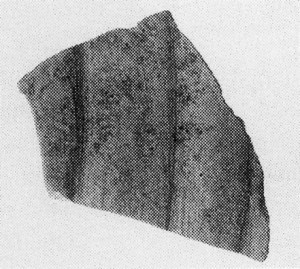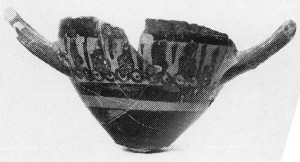Catalogue
(IP1293E) Conventionalizing broad-bottomed oinochoe
(a) H (pres): 0.056; W (pres): 0.063; D (est): 0.071;
d (est): 0.068.
(b) H (pres): 0.037; W (pres): 0.021.
(c) H (pres): 0.037; W (pres): 0.049, plus 5 other non-joining sherds.
Munsell: 10YR 7/1 (surface and core).
1/3 foot and underside, 1/4 body, fr. shoulder preserved.
Context: Deposit A, Pot Lots 111-112.
Concave underside; low straight flaring disk foot, trimmed at the bottom. Tall body, irregularly potted; nearly straight walls. There is a hint of concavity on the body before swelling slightly to the maximum diameter below the narrow, convex, slightly sloping shoulder/neck juncture. The slightly concave profile is probably the result of poor potting rather than development toward the concave oinochoe.
Bottom reserved; foot above trim, red. On the body: zone of unlinked silhouette lotuses and palmettes. On the shoulder: radiating dilute red and black lines with alternating red and black tongues. The drip-ring is red.
The clay is wholly grey, with some sherds mottled a different color.
The clay along several breaks shows the telltale coarsening of fire-burning, with traces of burning on the inside of (c).
Probably not much before ca. 460. The unlinked palmette/lotus chain on 1 is closely paralleled by the linked chain on a pyxis lid from the Potters’ Quarter at Corinth, KPI558 (A.N. Stillwell & J.L. Benson, Corinth XV:3, The Potters’ Quarter. The pottery, Princeton 1984, no. 958). 122
(IP 8323) . Unglazed lekanis lid.
H: 0.013; W: 0.031; L: 0.025.
Munsell: 7.5YR 7/2 (slip: 5YR 7/4).
Context: Deposit B, Pot Lot 215.
Stepped lid, the steps distinct but not clearly articulated.
Fire-burnt.
Second quarter of the 5th century, probably not early.
(IP345). Attic mug, Pheidias shape. H (pres): 0.022; D lip: 0.085,
Munsell (core): 10YR 6/2.
1/3 handle, 3/5 rim and lip extant.
Context: Deposit B, no Pot Lot.
Lower break at the articulation of the body/neck juncture. The lower neck is vertical and cylindrical. The upper neck curves through 90 degrees to the everted rounded lip. The vertical strap handle joins the lip horizontally.
Black-glazed inside and out. The sherd is fire-burnt, the clay coarsened at the break. There are traces of melted bronze adhering to the break.
Probably 460-450.
(IP 6749+6750a-c). Attic palmette skyphos, Hermogenean shape, variant.
H (pres): 0.049 (with handles, pres: 0.055); D: 0.071 (with handles: 0.109).
Munsel 1: 1 OYR 7/2, 8/2.
Foot, 2/5 body, 3/5 lip. Fragment of handle missing. Context: IP 6749 = Deposit A, Pot Lot 111; IP 6750a-c = Pot Lot 1307, Trs. EC-C, D, E.
Continuous convex curve front the narrow foot/body juncture to the slightly incurved tapered lip; the maximum diameter is on the upper body below the lip. Horizontal squared loop handles, round in section, are set at the maximum diameter and canted upwards just above the level of the lip.
The lower body is black-glazed, the upper body reserved. Outside of handle, interior of body black-glazed. Handle zone: sloppy silhouette palmette chain. The lower “tendrils” are a chain of tangent circles with central dot. The lumpy palmettes are divided by vertical strokes (degenerate buds). Each palmette is decorated with a white dot-rosette with red center and a red stroke on the central petal. The vase is badly fire-burnt.
Ca. 480-475.
Julie Bentz
555 W. Madison Street
Chicago, 11. 60661




